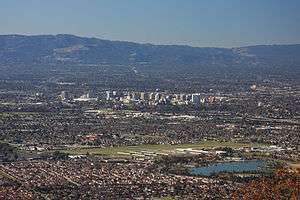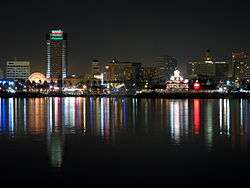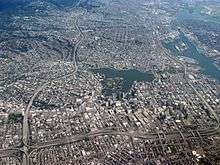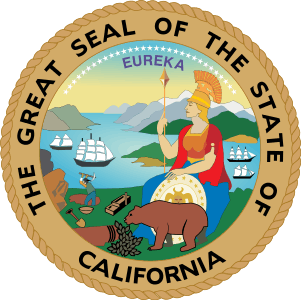California megapolitan areas
| California Megalopolis | |
|---|---|
| Megaregion | |
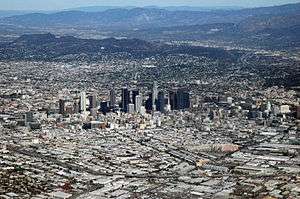 Los Angeles | |
 San Francisco | |
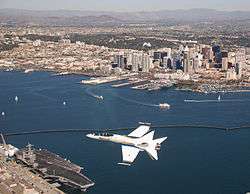 San Diego | |
| Country |
United States |
| State(s) |
California Nevada Baja California |
| Population | 41,888,491 |
California's major urban areas normally are thought of as two large megalopolises: one in Northern California and one in Southern California, separated from each other by approximately 382 miles or 615 km[1] (the distance from Los Angeles to San Francisco), with sparsely inhabited (relatively) Central Coast, Central Valley, and Transverse Ranges in between. Other ideas conceive of a single megalopolis encompassing both North and South, or a division of Coastal California vs. Inland California. These regional concepts usually are based on geographic, cultural, political, and environmental differences, rather than transportation and infrastructure connectivity and boundaries.
Notable conceptions of a California megalopolis
Futurists Herman Kahn and Anthony Wiener coined the name SanSan as an allusion to San Diego and San Francisco (along with BosWash and Chipitts) in The Year 2000[2][3] for a California megalopolis along the coast. The coastal emphasis does not conform to subsequent growth patterns extending to Metropolitan Sacramento and the Inland Empire.
Beyond Megalopolis, by Virginia Tech's Metropolitan Institute, defines two megapolitan areas which extend from California into Nevada: NorCal, which includes the Reno, Nevada area, and the Southland which encompasses Greater Los Angeles, the Inland Empire, and San Diego and includes Metropolitan Las Vegas.
America 2050,[4] an organization sponsored by the Rockefeller and Ford Foundations, lists 11 megaregions in the United States and Canada.[5] This includes the Southern and Northern California megaregions in which Southern California includes Greater Los Angeles, San Diego–Tijuana, the Inland Empire and Las Vegas Valley.[6]
None of the invented terms for a California megalopolis have ever achieved popular usage, as there has been little need for the general public to distinguish a California megalopolis from California as a whole or particular metropolitan areas such as the San Francisco Bay Area ("Bay Area") or the Greater Los Angeles Area ("L.A.").
Region
California is linked by Interstate 5, U.S. Route 101, California State Route 99 and California State Route 1 which start in the U.S.-Mexico border, Los Angeles, near Bakersfield and southern Orange County respectively, and terminate at the Oregon border (between Yreka and Ashland), the Oregon border (between Crescent City and Brookings), Red Bluff, and in northern Mendocino County respectively. The California High-Speed Rail, the first true high-speed rail network in the Americas, will connect Sacramento and the Bay Area to Los Angeles and San Diego with high-speed trains capable of 220 mph (350 km/h) linking San Francisco and Los Angeles in two and a half hours. Construction began in August 2010 with the construction of the new San Francisco Transbay Terminal.[7] As of the 2010 Census, the combined population of all of California's metropolitan regions is nearly 28.9 million (excluding San Diego, Reno, and Las Vegas), about 9.37% of the total US population, while the entire state of California had an estimated population of 44.2 million in 2017.
The megalopolis concept encompasses the combination of the megaregions of Northern California (composed of most of the region except extreme northern California and Eastern California counties of Modoc, Lassen, Plumas, Mono and Inyo) and Southern California (composed of the entire region except the county of Imperial) and spills into Baja California and Nevada with each proposed megaregion including the Reno metropolitan area, Metropolitan Las Vegas and Tijuana metropolitan area respectively.
Northern California holds 21 counties that are part of metropolitan areas, including one in Nevada, and includes an additional 17 neighboring counties and four Nevada counties in the sphere of influence.[8] Currently, all three of the metropolitan regions of Northern California (Bay Area, Greater Sacramento, and Metropolitan Fresno) are connected but are separated from Greater Los Angeles with Kings, Tulare and Kern Counties at the narrowest gap. However, one of metropolitan regions of each part of the state borders one of the two metropolitan regions of Nevada, Sacramento bordering Reno and Greater Los Angeles bordering Las Vegas.
Southern California holds the 8 counties and municipalities of Greater Los Angeles, Inland Empire and San Diego-Tijuana. Kern county and two Nevada counties are within the sphere of influence of Greater Los Angeles while Imperial County and Mexicali Municipality are held within San Diego-Tijuana's sphere of influence.[9]
The California Megalopolis with both the Northern and Southern megaregions would contain 3 of the 10 biggest cities in the US all with over 1 million each and 9 of the 50 biggest US cities, both the most of any megaregion in the country. On a global scale, the megapolitan area would contain three of the fifty largest cities in the Americas. The largest cities in descending order are: Los Angeles, San Diego, Tijuana, San Jose, San Francisco, Mexicali, Las Vegas, Fresno, Sacramento, Long Beach, Oakland, Bakersfield, Anaheim, and Santa Ana.
Northern California

California's economy as a whole is the largest of any state in the United States and is the fourth largest economy in the world.[10] The Northern California megaregion is home to the Silicon Valley with major corporations such as: Cisco Systems, Apple Inc., Oracle, EBay, Yahoo!, Facebook, YouTube, Google, and Hewlett Packard, the San Francisco Financial District (home to headquarters of various financial and business firms such as VISA, Wells Fargo, and Union Bank of California and is the largest financial district outside New York City), Wine Country, and much of the Central Valley which is one of the world's most productive agricultural areas, producing 8% of the nation's total crops. The centers of major national government offices, such as the United States Court of Appeals for the Ninth Circuit, the Federal Reserve Bank of San Francisco, and the U.S. Mint, as well as the California State Capitol and the California Supreme Court are all located within the region. The Bay Area also has the largest concentration of multi-millionaire households of any metropolitan area in the country and the largest concentration of billionaires of any U.S. metropolitan area, almost more than the next three metropolitan areas combined.[11]
Southern California
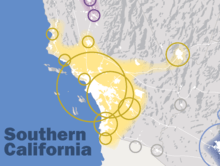
The Southern California megaregion is also a very economically important center in the U.S. Southern California is home to the Port of Los Angeles and Port of Long Beach (the first and second busiest container ports in the U.S. respectively) and the Port of San Diego.[12] The global center of the entertainment business, Southern California leads the world in the motion picture, television, and recorded music industry and is the home base for Hollywood, with studios such as The Walt Disney Company, ABC, Sony Pictures, Warner Bros., Universal Studios, MGM, Paramount Pictures, and 20th Century Fox headquartered here. Corporations such as Fox Sports Net, Guess, In-n-Out Burger, ARCO, Farmers, logistics, and many financial and banking companies are also based in the region. Southern California has long been the leading region in the U.S. for Aviation and Aerospace, and is one of the top five regions in the U.S. for the high-technology industry.
Southern California is also one of the world's largest tourist industries thanks to its famous beaches, entertainment districts such as L.A. Live and Sunset Boulevard, and theme parks including Disneyland, Knott's Berry Farm, and Universal Studios Hollywood. San Diego is an important port city, industrial, commercial, and shipbuilding center. It has a flourishing tourism industry, many research institutions, a large biomedical/biotechnology industry, and it is home to one of the largest concentrations of U.S. military bases and personnel of any large American city. Las Vegas is the largest city in Nevada, the world's second largest gambling/gaming center after Macau, and one of the fastest growing large cities and metropolitan areas in the United States.
Coastal and Inland California
The vast, relatively sparsely populated area of Central California weakens the proposal that California constitutes a single megalopolis. The northern and southern regions continue to grow toward one another, however, with much of this recent urbanization occurring not along the expensive and crowded coast itself — or even along the somewhat developed first tier of interior coastal valleys — but farther inland along a north-south axis through the midsection of the state in the Central Valley, Antelope Valley, Inland Empire and San Joaquin Valley regions, all comparatively more affordable areas which are becoming increasingly suburbanized as they are within commuting distance (albeit often a long commute) of the state's major coastal cities.[8]
Population
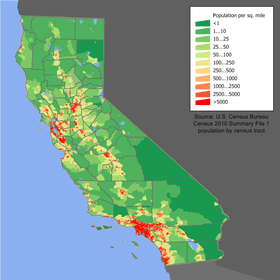
| Rank |
Urban agglomeration | GMP | Core citie(s) | State(s) | Census 2010 |
Census 2000 |
Growth 2000s |
|---|---|---|---|---|---|---|---|
| 1 | $604.8 billion[13] | CA | 12,828,837 | 12,365,627 | +3.75% | ||
| 2 | $487 billion[14] | CA | 7,468,390 | 6,783,760 | +10.09% | ||
| 3 | $133.3 billion | CA | 4,954,684 | 3,254,821 | +52.23% | ||
| 4 | $136.3 billion[15] | CA–BC | 4,947,694 | 4,129,433 | +19.82% | ||
| 5 | $118.8 billion | CA–NV | 2,461,780 | 2,069,298 | +18.97% | ||
| 6 | $103.3 billion | NV | 1,995,215 | 1,563,282 | +27.63% | ||
| 7 | — | CA | 1,081,315 | 922,516 | +17.21% | ||
| 8 | — | NV | 477,397 | 377,386 | +26.50% | ||
| 9 | — | NV | 55,274 | 52,457 | +5.37% | ||
| — | — | Total | CA–NV–BC | 36,364,071 | 32,271,777 | +12.68% |
Area composition
The California megalopolis contains a total of 56 counties and municipalities, 46 in California, 6 in Nevada and 4 in Baja California. Of those 56, 26 are part of combined statistical areas in California and 5 are part of metropolitan areas in Nevada, while the remaining six are part of international metropolitan area.
Greater Los Angeles:
San Francisco Bay Area:
- San Francisco
- San Mateo
- Alameda
- Contra Costa
- Santa Clara
- Marin
- Solano
- Sonoma
- Napa
- Santa Cruz
- San Benito
San Diego-Tijuana:
Metropolitan Vegas:
Greater Sacramento:
Mexicali-Calexico:
Metropolitan Fresno:
Area of influence (California):
- Santa Barbara
- Kern
- Redding
- San Joaquin
- Stanislaus
- Merced
- Mendocino
- Lake
- Monterey
- Amador
- Colusa
- Butte
- Sierra
- Alpine
- Kings
- Glenn
- Tulare
- Calaveras
- Tuolumne
- Mariposa
Area of influence (Nevada):
Image gallery
See also
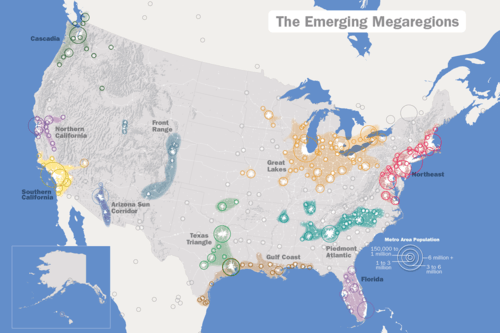
References
- ↑ "Distance between Los Angeles, CA and San Francisco, CA, mileage, gas calculator". check-distance.com. Retrieved 2016-12-27.
- ↑ The Year 2000: A Framework for Speculation on the Next Thirty-Three Years. New York: Macmillan. 1967. ISBN 0-02-560440-6.
- ↑ "Chipitts, Boswash & Sansan". Kiplinger's Personal Finance: 11. Jan 1968.
- ↑ http://www.america2050.org/about.html
- ↑ http://www.america2050.org/megaregions.html
- ↑ "Southern California Megaregion". Retrieved March 5, 2011.
- ↑
- 1 2 Metcalf, Gabriel; Terplan, Egon (November–December 2007). "The Northern California megaregion". The Urbanist. San Francisco Planning and Urban Research Association. Retrieved November 21, 2009.
- ↑ "Megaregions with Influence". America 2050. Retrieved March 5, 2011.
- ↑ "Report: California slips to world's 9th largest economy". CNN. January 13, 2012. Retrieved Jan 14, 2012.
- ↑ "America's Greediest Cities". Forbes. December 3, 2007.
- ↑ "North American Port Container Traffic - 2006" Archived 2008-12-19 at the Wayback Machine. - Port Industry Statistics - American Association of Port Authorities (AAPA) - Updated May 14, 2007 - (Adobe Acrobat *.PDF document)
- ↑ "U.S. Metro Economies: GMP – The Engines of America's Growth" (PDF). usmayors.org. Archived from the original (PDF) on May 12, 2011. Retrieved March 18, 2011.
- ↑ Abate, Tom (September 8, 2009). "California 8th among world economies". SFGate.com. Retrieved March 18, 2011.
- ↑ San Diego-Tijuana GRP Archived July 23, 2011, at the Wayback Machine.

